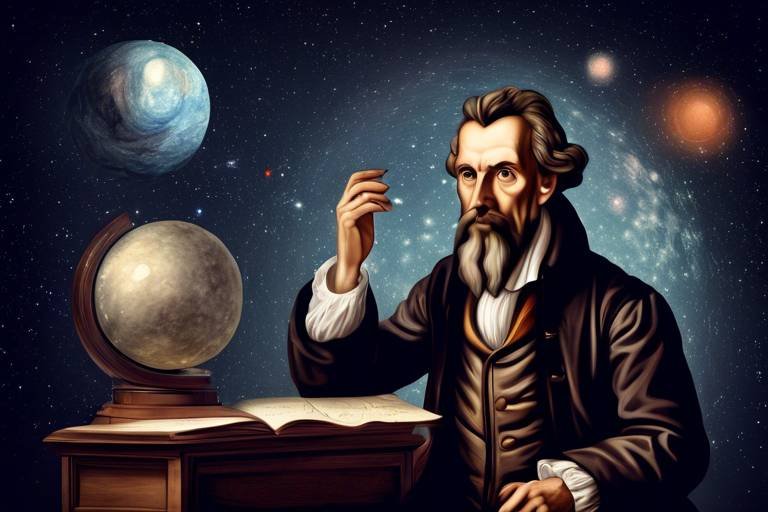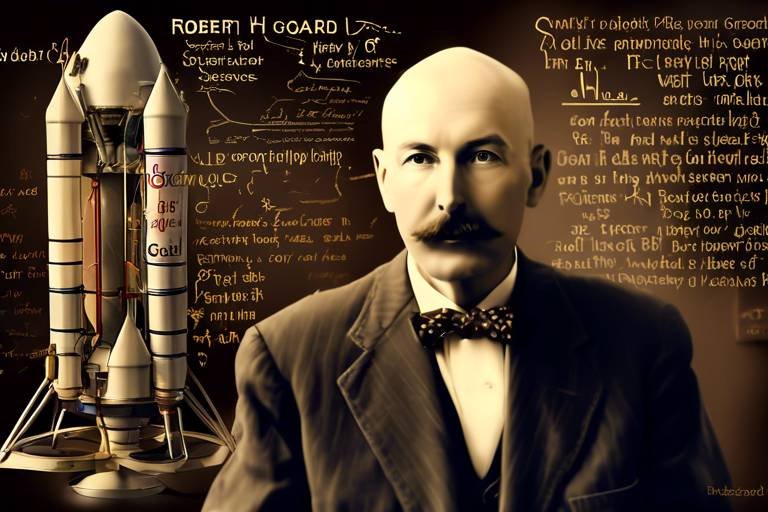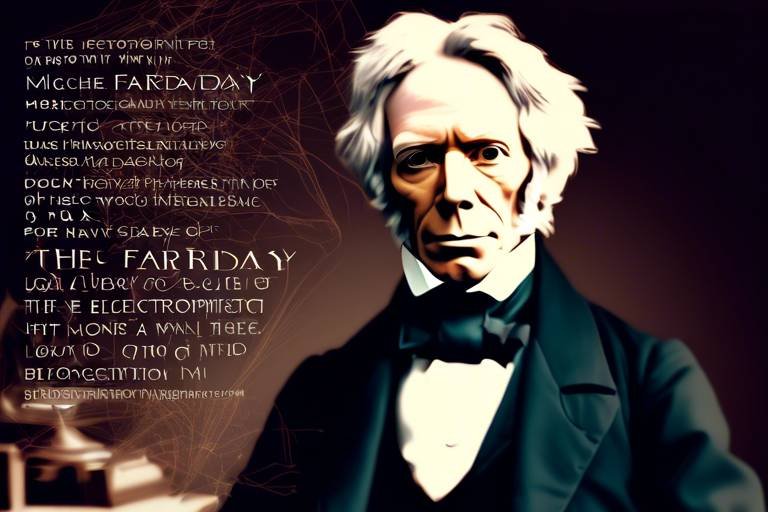The Discoveries of Johannes Kepler in Astronomy
When we think about the cosmos and the intricate dance of planets, we often overlook the brilliant minds that paved the way for our understanding of the universe. One such mind is Johannes Kepler, a German mathematician and astronomer who revolutionized the field of astronomy in the early 17th century. His groundbreaking work not only challenged long-standing beliefs but also laid the foundation for modern celestial mechanics. Kepler's discoveries, particularly his laws of planetary motion, transformed our understanding of how planets orbit the Sun, shifting the paradigm from circular orbits to elliptical paths. This shift was monumental, akin to discovering that the Earth isn't the center of the universe but rather a part of a much larger, dynamic system.
Kepler's journey began with a simple yet profound question: How do planets move? Through meticulous observations and calculations, he unlocked the secrets of planetary motion, revealing that the universe operates under specific mathematical principles. His three laws of planetary motion—the law of elliptical orbits, the law of equal areas, and the harmonic law—not only changed the way we view the solar system but also influenced various scientific disciplines, from physics to engineering. Imagine being able to predict the position of a planet in the night sky with incredible accuracy; this was the gift Kepler bestowed upon humanity.
As we delve deeper into Kepler's discoveries, we will explore each of his laws and their profound implications. We'll see how his insights not only enhanced our understanding of the solar system but also inspired future generations of scientists, including the likes of Isaac Newton. Kepler's work was a pivotal turning point in the history of astronomy, marking the transition from ancient theories based on philosophical musings to a more rigorous, mathematical approach to understanding the cosmos. So, buckle up as we embark on this journey through the stars, guided by the brilliance of Johannes Kepler!
- What are Kepler's three laws of planetary motion? Kepler's three laws describe how planets move in elliptical orbits, sweep out equal areas in equal times, and relate orbital periods to their distances from the Sun.
- Why are Kepler's laws important? They laid the foundation for modern astronomy and helped scientists understand the mechanics of celestial bodies, influencing future research and discoveries.
- How did Kepler's work influence Isaac Newton? Kepler's laws provided a mathematical framework that Newton built upon to develop his own theories of gravity and motion.

Kepler's Laws of Planetary Motion
Johannes Kepler, a name that resonates through the corridors of astronomy, made profound contributions that reshaped our understanding of the cosmos. His formulation of the three laws of planetary motion was not merely a collection of observations; it was a revolutionary shift that challenged centuries of astronomical thought. Before Kepler, the prevailing belief was that planets moved in perfect circles around the Sun. However, Kepler's meticulous observations, particularly those of the astronomer Tycho Brahe, led him to unveil a new reality: planets travel in elliptical orbits. This was a game-changer, one that turned the wheels of scientific inquiry and pushed humanity closer to understanding the universe's intricate dance.
Kepler's laws are not just a set of rules; they are the foundation upon which modern astronomy stands. The first law, which we will explore in detail, describes the shape of planetary orbits. The second law reveals the speed at which planets travel, and the third law elegantly connects a planet's distance from the Sun with its orbital period. Together, these laws paint a comprehensive picture of how celestial bodies interact within our solar system and beyond. They are akin to a musical score, where each note contributes to a harmonious understanding of the celestial symphony.
To appreciate the significance of Kepler's laws, one must consider the context of his time. In an era dominated by the geocentric model, where Earth was believed to be the center of the universe, Kepler's insights were revolutionary. They not only provided a more accurate description of planetary motion but also laid the groundwork for future astronomers and physicists, including the legendary Isaac Newton. Newton's laws of motion and universal gravitation would later build upon Kepler's findings, creating a robust framework for understanding the forces that govern celestial mechanics.
Kepler's laws are encapsulated as follows:
- First Law: Planets move in elliptical orbits with the Sun at one focus.
- Second Law: A line segment joining a planet and the Sun sweeps out equal areas during equal intervals of time.
- Third Law: The square of the orbital period of a planet is directly proportional to the cube of the semi-major axis of its orbit.
These laws not only revolutionized astronomy but also had far-reaching implications in various scientific fields. The understanding of elliptical motion, for instance, has applications in physics, engineering, and even space exploration. Imagine the precision required for launching a spacecraft; it’s all rooted in the principles laid out by Kepler. His work encourages us to look at the universe not as a chaotic expanse but as a structured system governed by predictable laws.
In conclusion, Kepler's laws of planetary motion are more than just historical milestones; they are a testament to human curiosity and intellect. They invite us to ponder the vastness of the universe and our place within it. As we delve deeper into each of these laws in the subsequent sections, we will uncover the beauty and complexity of the celestial mechanics that govern our solar system.

Kepler's First Law: The Elliptical Orbits
Imagine a world where the planets dance around the Sun, not in perfect circles, but in graceful, elongated shapes known as ellipses. This was a revolutionary idea proposed by Johannes Kepler in the early 17th century, challenging centuries of astronomical thought. Before Kepler, many believed that celestial bodies moved in circular orbits, a notion deeply rooted in the teachings of the ancient Greeks. However, Kepler's first law shattered this misconception, revealing that the orbits of planets are not just circles but ellipses, with the Sun nestled at one of the foci. This groundbreaking insight not only transformed the field of astronomy but also laid the foundation for modern celestial mechanics.
To understand the significance of this first law, we need to delve a bit into the mathematics of ellipses. An ellipse can be defined as a shape created by the intersection of a plane and a cone, resulting in a curve that is elongated rather than round. The distance from the center of the ellipse to the foci is what gives it that unique shape. In Kepler's model, the Sun is positioned at one focus, while the other focus remains empty, creating a dynamic space where planets move in a predictable yet varied manner.
Mathematically, an ellipse can be described by the equation:
(x²/a²) + (y²/b²) 1
In this equation, a represents the semi-major axis (the longest radius), and b is the semi-minor axis (the shortest radius). The relationship between these axes helps define the eccentricity of the ellipse, which indicates how 'stretched out' it is. A perfect circle has an eccentricity of 0, while an ellipse can have values between 0 and 1. Kepler’s first law fundamentally changed our understanding of how planets travel through space, as it introduced the idea that their speed and position are not constant but rather influenced by their distance from the Sun.
The implications of elliptical orbits extend far beyond astronomy. They have profound effects on various scientific fields, including physics and engineering. For instance, understanding the elliptical paths of satellites can enhance the design of space missions and the trajectories of spacecraft. In engineering, the principles of elliptical motion can be applied to create more efficient systems in mechanical design and robotics.
Moreover, Kepler's first law paved the way for future scientific explorations and theories. It encouraged astronomers to look beyond the rigid circular models and embrace the complexities of celestial mechanics. The realization that planets move faster when closer to the Sun and slower when farther away (a concept that arises from the elliptical nature of their orbits) has implications for gravitational studies and the understanding of forces at play in the universe.
In summary, Kepler's first law of planetary motion was not just a simple observation; it was a profound revelation that reshaped our understanding of the cosmos. By recognizing that planets travel in elliptical orbits, Kepler opened the door to a new era of astronomical discovery, one that continues to influence science today.
- What is Kepler's first law? Kepler's first law states that planets move in elliptical orbits with the Sun at one focus.
- How does this law compare to previous beliefs? Prior to Kepler, many believed planets moved in perfect circular orbits.
- What are the implications of elliptical orbits? Elliptical orbits influence various scientific fields, including physics and engineering, and are crucial for understanding celestial mechanics.

Understanding Ellipses
When we think about orbits, the image that often comes to mind is a perfect circle. However, Kepler's first law introduced a fascinating twist to our understanding of planetary motion: planets travel in elliptical orbits. This revelation was nothing short of revolutionary. An ellipse is a geometric shape that resembles a stretched-out circle, defined by two focal points. In the case of our solar system, one of these focal points is occupied by the Sun, while the other remains empty. This means that planets are not always equidistant from the Sun; instead, their distance varies as they move along their elliptical paths.
To visualize this, imagine a racetrack. If you're running on a circular track, your distance from the center remains constant. But if you're on an elliptical track, sometimes you're closer to the center, and sometimes you're farther away. This variability in distance is crucial because it affects not just the speed of the planets, but also their gravitational interactions with other celestial bodies.
Mathematically, an ellipse is defined by its major axis and minor axis. The major axis is the longest diameter of the ellipse, while the minor axis is the shortest. The relationship between these axes determines the shape of the ellipse. The closer the two foci are to each other, the more circular the ellipse appears. Conversely, when they are farther apart, the ellipse becomes more elongated. This concept is essential in understanding how planets travel through space.
In terms of equations, the standard form of an ellipse can be expressed as:
(x²/a²) + (y²/b²) 1
Where a represents the semi-major axis, and b represents the semi-minor axis. This mathematical representation allows astronomers to calculate various properties of elliptical orbits, such as the area swept out by a planet in a given time frame. Kepler's insights transformed the way we perceive the cosmos, emphasizing that the universe is far more complex and beautiful than the simplistic view of circular orbits.
Understanding ellipses not only enriches our knowledge of planetary motion but also enhances our grasp of other scientific fields. For example, in physics, the principles of elliptical motion are applied to satellite trajectories and the dynamics of various celestial phenomena. In engineering, the concept of ellipses is utilized in designing components that require precise movement along curved paths. Thus, Kepler's work on elliptical orbits serves as a cornerstone for multiple disciplines, showcasing the interconnectedness of scientific principles.

Implications of Elliptical Orbits
The implications of elliptical orbits extend far beyond the realm of astronomy, touching various fields such as physics, engineering, and even our daily lives. When Kepler proposed that planets traveled in elliptical paths rather than perfect circles, he turned the scientific community on its head. This revolutionary idea not only reshaped our understanding of the solar system but also laid the groundwork for future scientific advancements. Imagine trying to navigate a winding road versus a straight highway; the challenges and calculations differ vastly, much like the implications of elliptical versus circular orbits.
One of the most significant implications of elliptical orbits is their influence on gravitational theories. The realization that celestial bodies follow elliptical paths has led to a deeper understanding of gravitational forces. For instance, when we consider how planets interact with one another, we see that their positions and velocities are not constant. Instead, they vary based on their distance from the Sun and other planets. This variability is crucial for predicting events such as planetary alignments and eclipses.
Moreover, the concept of elliptical orbits has profound ramifications in the field of engineering. When designing spacecraft, engineers must account for the elliptical trajectories that these vehicles will follow when entering or exiting a planet's gravitational influence. This is particularly important for missions to distant planets or moons, where precise calculations can mean the difference between success and failure. For example, the trajectory of the Voyager spacecraft was meticulously planned using Kepler's laws to ensure it could escape Earth's gravitational pull and reach the outer planets.
In addition, elliptical orbits have applications in satellite technology. Satellites in elliptical orbits experience variations in speed and altitude, which can affect their communication capabilities. Understanding these dynamics helps engineers design better satellites that can maintain a stable connection with ground stations. This knowledge is vital for technologies we use every day, from GPS systems to weather forecasting.
To illustrate the interconnectedness of elliptical orbits with other scientific principles, consider the following table that summarizes how these orbits influence various fields:
| Field | Implication |
|---|---|
| Astronomy | Understanding planetary motions and predicting celestial events. |
| Physics | Insights into gravitational forces and their effects on motion. |
| Engineering | Designing spacecraft trajectories for successful missions. |
| Satellite Technology | Improving satellite communication and stability in orbit. |
In conclusion, the implications of elliptical orbits are vast and varied, touching upon critical aspects of science and technology. By challenging the traditional views of circular orbits, Kepler opened the door to a deeper understanding of the universe and its laws. His discoveries continue to influence not only astronomers but also engineers, physicists, and everyday technology users. Just as a ripple spreads across a pond, the effects of Kepler's findings continue to resonate throughout the scientific community and beyond.
- What are Kepler's laws of planetary motion?
Kepler's laws describe how planets move around the Sun, including their elliptical orbits, varying speeds, and the relationship between their orbital periods and distances from the Sun. - Why are elliptical orbits important?
Elliptical orbits provide a more accurate representation of how celestial bodies move, influencing fields such as astronomy, physics, and engineering. - How do elliptical orbits affect satellite technology?
Satellites in elliptical orbits experience variations in speed and altitude, which can impact their communication capabilities and overall functionality.

Kepler's Second Law: The Equal Areas
Kepler's second law, often referred to as the law of equal areas, is a stunning revelation that adds depth to our understanding of planetary motion. It states that a line segment joining a planet and the Sun sweeps out equal areas during equal intervals of time. This means that a planet moves faster when it is closer to the Sun and slower when it is farther away. Imagine a racetrack where the racers speed up as they approach the finish line and slow down when they move away. This law not only challenges our intuitive notions about how planets should move but also illustrates the intricate dance of celestial bodies in our solar system.
To visualize this, picture an ellipse with the Sun at one of its foci. As a planet travels along its elliptical orbit, the area swept out by the line connecting the planet to the Sun remains constant over equal time periods. This principle can be represented graphically, showcasing how the distance from the Sun affects the speed of the planet. In essence, Kepler's second law reveals the dynamic nature of celestial motion, emphasizing that the universe is not a static place but a vibrant, ever-changing system.
The implications of Kepler's second law extend far beyond mere observation. For astronomers and physicists, understanding how planets accelerate and decelerate is crucial for predicting their positions and movements. This knowledge is particularly significant when planning space missions or studying the orbits of exoplanets. In fact, the law is foundational in modern astronomy, assisting scientists in calculating trajectories and ensuring that spacecraft reach their destinations safely and efficiently.
In summary, Kepler's second law reshapes our understanding of planetary motion, illustrating the beautiful complexity of our solar system. It serves as a reminder that the universe operates on principles that often defy our expectations, and it encourages us to delve deeper into the mysteries of celestial mechanics. As we continue to explore the cosmos, Kepler's insights remain a guiding light, illuminating the path for future discoveries.
- What is Kepler's second law? Kepler's second law states that a line segment joining a planet and the Sun sweeps out equal areas during equal intervals of time, indicating that planets move faster when they are closer to the Sun.
- How does Kepler's second law impact modern astronomy? This law helps astronomers predict the positions and movements of celestial bodies, which is essential for planning space missions and understanding the dynamics of planetary systems.
- Why are elliptical orbits important? Elliptical orbits, as described by Kepler, allow for variations in speed and distance, showcasing the complex interactions between gravitational forces and motion in the universe.

Planetary Speed Variations
Have you ever wondered why planets seem to zip around the Sun at different speeds? It's a fascinating aspect of astronomy that Kepler's Second Law, also known as the Law of Equal Areas, brilliantly explains. According to this law, a line segment joining a planet and the Sun sweeps out equal areas during equal intervals of time. This means that when a planet is closer to the Sun, it moves faster, and when it’s farther away, it slows down. It’s almost like a cosmic dance where the closer you are to the center stage, the more energetic your performance!
To put it simply, think of a figure skater pulling in their arms to spin faster. As they get closer to the center of their spin, they move quicker. Similarly, planets experience a change in speed based on their distance from the Sun. This dynamic nature of celestial motion is not just a quirky fact; it has profound implications for our understanding of planetary orbits.
Let’s break it down further. When a planet is at its closest point to the Sun, known as perihelion, it speeds up significantly. Conversely, at its farthest point, called aphelion, it slows down. This variation in speed is crucial for astronomers when calculating the orbits of planets and predicting their positions. The visual representation of this concept can be quite striking:
| Planet | Perihelion (Closest Point) | Aphelion (Farthest Point) | Average Speed (km/s) |
|---|---|---|---|
| Mercury | 57.91 million km | 69.82 million km | 47.87 |
| Venus | 107.48 million km | 109.18 million km | 35.02 |
| Earth | 147.09 million km | 152.10 million km | 29.78 |
| Mars | 206.62 million km | 250.23 million km | 24.07 |
This table illustrates how the distance from the Sun affects the speed of different planets. As you can see, Mercury, being the closest planet to the Sun, has the highest average speed, while Mars, being farther away, moves much slower. This relationship not only helps astronomers in their observations but also opens the door to understanding the fundamental mechanics of our solar system.
In essence, Kepler's insights into planetary speed variations have paved the way for modern astronomy. Without this understanding, predicting the movements of celestial bodies would be like trying to catch smoke with your bare hands—impossible! So next time you gaze up at the night sky, remember that the planets are not just floating aimlessly; they are in constant motion, influenced by the Sun's gravitational pull in a beautifully orchestrated ballet of speed and distance.
- What is Kepler's Second Law? Kepler's Second Law states that a line segment joining a planet and the Sun sweeps out equal areas during equal intervals of time, indicating that planets move faster when closer to the Sun.
- Why do planets move faster at certain points in their orbits? Planets move faster at perihelion (closest to the Sun) due to the stronger gravitational pull, while they slow down at aphelion (farthest from the Sun).
- How does this law affect our understanding of the solar system? It helps astronomers predict planetary positions and understand the dynamics of celestial mechanics, influencing everything from spacecraft navigation to our understanding of other planetary systems.

Applications in Modern Astronomy
Kepler's second law, which elegantly illustrates that a line segment joining a planet to the Sun sweeps out equal areas during equal time intervals, has profound implications in the field of modern astronomy. This principle not only enhances our understanding of planetary motion but also serves as a foundational concept for various astronomical applications. For instance, when astronomers track the movements of celestial bodies, they utilize Kepler's insights to predict their positions with remarkable accuracy. Imagine trying to catch a moving train; knowing its speed and direction is crucial. Similarly, Kepler's laws allow astronomers to forecast where planets will be in the future, enabling them to plan observations and missions effectively.
Moreover, Kepler's second law is instrumental in the study of exoplanets—planets that orbit stars outside our solar system. By analyzing the light curves of these distant worlds, astronomers can determine their orbital characteristics, including their speed variations as they move closer to or farther from their host stars. This information is vital for understanding the habitability of these planets, as it helps scientists assess the potential for life based on their distance from the star and the energy they receive.
In addition, Kepler's second law finds applications in the realm of astrodynamics, which deals with the motion of spacecraft. When planning missions, engineers must consider the gravitational influences of various celestial bodies. By applying Kepler's principles, they can calculate efficient trajectories that minimize fuel consumption while maximizing speed. This is akin to finding the best route in a city—taking into account traffic patterns and road conditions to arrive at your destination as quickly as possible.
Furthermore, the implications of Kepler's second law extend to the field of gravitational studies. Understanding how objects move under the influence of gravity allows scientists to explore the dynamics of galaxies, star clusters, and even the motion of dark matter. The interplay between speed and distance, as defined by Kepler, helps astronomers decipher the complex gravitational interactions that govern the universe.
In summary, Kepler's second law is not merely a historical footnote; it is a vital tool in contemporary astronomy. Its applications range from predicting planetary positions to enhancing our understanding of exoplanets and spacecraft navigation. Without these foundational insights, our grasp of the cosmos would be far less comprehensive.
- What are Kepler's three laws of planetary motion?
Kepler's three laws describe how planets move around the Sun: 1) planets travel in elliptical orbits with the Sun at one focus, 2) a line connecting a planet to the Sun sweeps out equal areas in equal times, and 3) the square of a planet's orbital period is proportional to the cube of its average distance from the Sun. - How did Kepler's laws change our understanding of the universe?
Kepler's laws challenged the long-held belief in circular orbits and laid the groundwork for Newton's laws of motion and universal gravitation, fundamentally changing how we understand celestial mechanics. - What is the significance of elliptical orbits?
Elliptical orbits indicate that planets do not travel at a constant speed; instead, they move faster when closer to the Sun and slower when farther away, which has implications for gravitational interactions and energy distribution in space.

Kepler's Third Law: The Harmonic Law
Kepler's Third Law, often referred to as the Harmonic Law, is a remarkable insight into the relationship between a planet's distance from the Sun and the time it takes to complete an orbit. Simply put, this law states that the square of the orbital period of a planet (the time it takes to make one complete revolution around the Sun) is directly proportional to the cube of the semi-major axis of its orbit (essentially, the average distance from the Sun). Mathematically, this can be expressed as:
T² ∝ a³
Here, T represents the orbital period, and a represents the semi-major axis. This simple yet profound relationship allows astronomers to predict the behavior of planets in our solar system and beyond. Imagine trying to navigate a vast ocean without a map; Kepler's Third Law provides that essential navigation tool, giving us a clearer understanding of the cosmic dance of celestial bodies.
To illustrate this further, consider the following table that summarizes the orbital periods and average distances of some planets in our solar system:
| Planet | Average Distance from the Sun (AU) | Orbital Period (Earth Years) |
|---|---|---|
| Mercury | 0.39 | 0.24 |
| Venus | 0.72 | 0.615 |
| Earth | 1.00 | 1.00 |
| Mars | 1.52 | 1.88 |
| Jupiter | 5.20 | 11.86 |
| Saturn | 9.58 | 29.46 |
As you can see from the table, there’s a clear pattern that emerges when we apply Kepler’s Third Law. For instance, while Mercury orbits the Sun at a mere 0.39 AU (astronomical units), it completes its revolution in just 0.24 Earth years. On the other hand, Saturn, which is much farther away at 9.58 AU, takes nearly 29.5 Earth years to complete one orbit. This relationship not only showcases the harmony of the solar system but also serves as a foundation for understanding more complex systems, such as exoplanets orbiting distant stars.
Furthermore, Kepler's Third Law has had a profound influence on future astronomers and scientists. It laid the groundwork for later figures like Isaac Newton, who built upon Kepler's findings to formulate his own laws of motion and universal gravitation. This intertwining of ideas demonstrates how scientific progress often builds upon the shoulders of giants, creating a legacy that shapes our understanding of the universe.
In modern astronomy, Kepler’s Third Law continues to be relevant. It is used not just for calculating the orbits of planets but also for determining the masses of celestial objects based on their gravitational effects. The law has applications in various fields, including astrophysics, space exploration, and even the study of binary star systems.
- What is Kepler's Third Law? Kepler's Third Law states that the square of a planet's orbital period is proportional to the cube of the semi-major axis of its orbit.
- How does Kepler's Third Law apply to other celestial bodies? The law can be applied to any orbiting body, including moons and artificial satellites, to predict their orbital periods based on their distance from the primary body they orbit.
- Why is Kepler's Third Law important? It provides a fundamental understanding of the dynamics of planetary systems and has influenced the development of modern physics and astronomy.

Mathematical Formulation
Kepler's third law, often referred to as the harmonic law, provides a fascinating insight into the relationship between a planet's orbital period and its distance from the Sun. To put it simply, this law states that the square of the orbital period (T) of a planet is directly proportional to the cube of the semi-major axis (a) of its orbit. This relationship can be expressed mathematically as:
T² ∝ a³
In more formal terms, we can write the equation as:
T² k * a³
Here, k is a constant that applies to all planets orbiting the same star. This equation is groundbreaking because it allows astronomers to predict the behavior of planets based on their distance from the Sun. For instance, if we know the distance of a planet from the Sun, we can easily calculate how long it takes to complete one orbit. This is not just theoretical; it has practical applications in both astronomy and space exploration.
To illustrate this further, let’s consider a table that summarizes the orbital periods and distances of some of our solar system’s planets:
| Planet | Distance from Sun (AU) | Orbital Period (Earth Years) |
|---|---|---|
| Mercury | 0.39 | 0.24 |
| Venus | 0.72 | 0.61 |
| Earth | 1.00 | 1.00 |
| Mars | 1.52 | 1.88 |
| Jupiter | 5.20 | 11.86 |
| Saturn | 9.58 | 29.46 |
This table shows how, as the distance from the Sun increases, the orbital period also increases, which aligns perfectly with Kepler's third law. For example, Jupiter, which is farthest from the Sun in this table, takes almost 12 Earth years to complete one orbit, while Mercury, being closest, takes only about 88 Earth days.
Moreover, Kepler's third law is not just limited to our solar system. It can be applied to any two objects orbiting a common center of mass, including moons around planets or even stars in binary systems. This universality highlights the profound impact of Kepler's work on our understanding of celestial mechanics.
In conclusion, the mathematical formulation of Kepler's third law not only enhances our knowledge of planetary orbits but also serves as a fundamental principle that continues to influence modern astronomy and astrophysics. By bridging the gap between distance and time, Kepler has left an indelible mark on the scientific community, paving the way for future explorations of the cosmos.
- What is Kepler's third law? Kepler's third law states that the square of the orbital period of a planet is directly proportional to the cube of the semi-major axis of its orbit.
- How does Kepler's third law apply to other celestial bodies? It can be applied to any two objects orbiting a common center of mass, such as moons around planets or stars in binary systems.
- Why is Kepler's third law important? It allows astronomers to predict the behavior of celestial bodies based on their distance from the Sun, which has practical applications in space exploration.

Influence on Future Astronomers
Johannes Kepler's contributions to astronomy were nothing short of revolutionary, and his influence can be seen cascading through the works of many future astronomers. His laws of planetary motion did not merely provide a new model for understanding the solar system; they laid the groundwork for the scientific revolution that followed. Imagine standing on the shoulders of a giant—this is precisely what figures like Isaac Newton did when they built upon Kepler's findings.
One of the most profound impacts of Kepler's work was the introduction of a mathematical framework to describe celestial motion. Before Kepler, astronomers relied heavily on complex epicycles and circular orbits, which often led to inaccuracies. With Kepler's laws, particularly the third law, future astronomers could predict the positions of planets with remarkable precision. This shift from qualitative descriptions to quantitative analysis was a game changer. It was like moving from painting a blurry picture to capturing a high-definition photograph of the cosmos.
Moreover, Kepler's emphasis on observation and empirical data inspired subsequent astronomers to prioritize measurement and experimentation. His meticulous records of planetary positions, especially those based on Tycho Brahe's observations, encouraged a culture of rigorous scientific inquiry. This approach paved the way for the likes of Galileo Galilei, who would later utilize telescopic observations to further unravel the mysteries of the universe.
Kepler's influence extended beyond just his immediate successors. His work can be seen as a catalyst for the development of celestial mechanics, which became foundational for later scientists. In fact, Newton's law of universal gravitation, which describes the gravitational force between two bodies, was heavily influenced by the mathematical relationships established by Kepler. The connection between Kepler's laws and Newton's gravitational theory is a perfect example of how one scientific breakthrough can lead to another, creating a domino effect of knowledge.
Additionally, Kepler's ideas didn't just remain confined to astronomy; they also found relevance in various scientific fields. For instance, the principles behind elliptical orbits have applications in physics, engineering, and even space exploration. The way spacecraft are designed to travel around celestial bodies often relies on the very laws that Kepler articulated centuries ago. It's fascinating to think that a 17th-century astronomer could influence the trajectory of modern space missions!
In summary, Johannes Kepler's influence on future astronomers is profound and far-reaching. His laws of planetary motion not only transformed the understanding of our solar system but also instigated a shift towards a more scientific approach to astronomy and physics. His legacy is a reminder that in the world of science, ideas are interconnected, and one discovery can illuminate the path for many others.
- What are Kepler's three laws of planetary motion? Kepler's three laws describe how planets move in elliptical orbits around the Sun, sweep out equal areas in equal times, and relate the time of orbit to the distance from the Sun.
- How did Kepler's laws change astronomy? They provided a more accurate model of planetary motion, replacing the previous reliance on circular orbits and epicycles, and laid the groundwork for future scientific advancements.
- Who were some astronomers influenced by Kepler? Isaac Newton is one of the most notable astronomers influenced by Kepler, as his laws of motion and universal gravitation built upon Kepler's findings.
- What is the significance of elliptical orbits? Elliptical orbits explain the varying speeds of planets as they orbit the Sun, which was a significant departure from the previously held belief in circular orbits.
Frequently Asked Questions
- What are Kepler's three laws of planetary motion?
Kepler's three laws describe the motion of planets around the Sun. The first law states that planets move in elliptical orbits with the Sun at one focus. The second law explains that a line segment joining a planet and the Sun sweeps out equal areas during equal intervals of time. The third law establishes a relationship between the time a planet takes to orbit the Sun and its distance from the Sun.
- How did Kepler's first law change our understanding of the solar system?
Kepler's first law challenged the long-held belief that planets moved in perfect circular orbits. By demonstrating that orbits are elliptical, he fundamentally reshaped our models of the solar system, leading to a more accurate understanding of planetary motion and the gravitational forces at play.
- What is the significance of Kepler's second law in astronomy?
Kepler's second law reveals how a planet's speed varies depending on its distance from the Sun. This law is crucial for understanding the dynamics of celestial motion, as it shows that planets travel faster when they are closer to the Sun and slower when they are farther away, influencing predictions about planetary positions.
- Can you explain Kepler's third law in simple terms?
Kepler's third law states that the square of the orbital period of a planet is directly proportional to the cube of its average distance from the Sun. In simpler terms, this means that the farther a planet is from the Sun, the longer it takes to complete an orbit. This law helps us understand the relationships between different planetary systems.
- How did Kepler's discoveries influence future astronomers?
Kepler's discoveries laid the groundwork for modern astronomy and significantly influenced future astronomers, including Isaac Newton. His laws provided a mathematical framework that helped explain gravitational forces and celestial mechanics, paving the way for advancements in our understanding of the universe.
- Why are Kepler's laws still relevant today?
Kepler's laws remain relevant because they provide fundamental insights into the motion of celestial bodies. They are still used in modern astronomy for calculating the orbits of planets, moons, and artificial satellites, making them essential for space exploration and understanding the dynamics of our solar system.



















